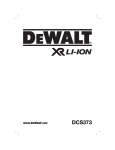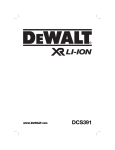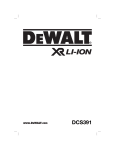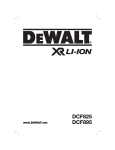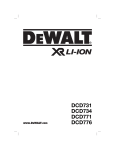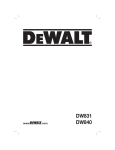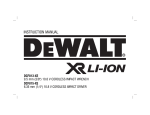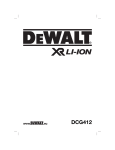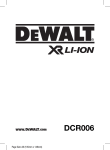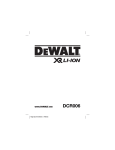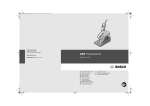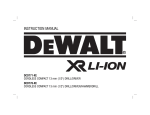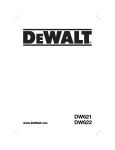Download DeWalt DCG412-XE Technical data
Transcript
DCG412 English (original instructions) 4 Copyright DEWALT B Figure 1 j b e a e f d i c g s h Figure 2 j j o p 1 Figure 3 l k n i d m m Figure 4 > 3.17 mm (1/8") h h g f g < 3.17 mm (1/8") d h g Figure 5 l m n i k 2 Figure 6 Figure 7 b a 3 ENGLISH CORDLESS GRINDER DCG412 An estimation of the level of exposure to vibration should also take into account the times when the tool is switched off or when it is running but not actually doing the job. This may significantly reduce the exposure level over the total working period. Congratulations! You have chosen a DEWALT tool. Years of experience, thorough product development and innovation make DEWALT one of the most reliable partners for professional power tool users. Technical Data Voltage Type Power input No-load/rated speed Wheel diameter Spindle diameter Spindle length Weight (without battery pack) VDC W min-1 mm mm kg DCG412 18 2/10 405 8000 125 M14 16 1.9* * weight includes side handle and guard Noise values and vibration values (triax vector sum) according to EN 60745-2-3: LPA (emission sound pressure level) dB(A) 84 LWA (sound power level) dB(A) 95 KWA (uncertainty for the given sound level) dB(A) 3.5 Surface grinding Vibration emission value ah,AG = Uncertainty K = m/s² m/s² 7.1 2.2 NOTE: Applications such as cutting-off or wire brushing may have different vibration emissions. The vibration emission level given in this information sheet has been measured in accordance with a standardised test given in EN 60745 and may be used to compare one tool with another. It may be used for a preliminary assessment of exposure. WARNING: The declared vibration emission level represents the main applications of the tool. However if the tool is used for different applications, with different accessories or poorly maintained, the vibration emission may differ. This may significantly increase the exposure level over the total working period. 4 Identify additional safety measures to protect the operator from the effects of vibration such as: maintain the tool and the accessories, keep the hands warm, organisation of work patterns. Battery pack Battery type Voltage Capacity Weight Battery pack Battery type Voltage Capacity Weight Charger Mains voltage Battery type Approximate charging time of battery packs Weight Charger Mains voltage Battery type Approximate charging time of battery packs Weight Fuses Europe U.K. & Ireland VDC Ah kg DCB180 Li-Ion 18 3.0 0.64 DCB181 Li-Ion 18 1.5 0.35 DCB182 Li-Ion 18 4.0 0.61 VDC Ah kg DCB183 Li-Ion 18 2.0 0.40 DCB184 Li-Ion 18 5.0 0.62 DCB185 Li-Ion 18 1.3 0.35 VAC min 25 (1.3 Ah) 55 (3.0 Ah) kg VAC min 60 (1.3 Ah) 140 (3.0 Ah) kg 230 V tools 230 V tools DCB105 230 V Li-Ion 30 (1.5 Ah) 70 (4.0 Ah) 0.49 DCB107 230 V Li-Ion 70 (1.5 Ah) 185 (4.0 Ah) 0.29 40 (2.0 Ah) 90 (5.0 Ah) 90 (2.0 Ah) 240 (5.0 Ah) 10 Amperes, mains 13 Amperes, in plugs ENGLISH Definitions: Safety Guidelines The definitions below describe the level of severity for each signal word. Please read the manual and pay attention to these symbols. DANGER: Indicates an imminently hazardous situation which, if not avoided, will result in death or serious injury. WARNING: Indicates a potentially hazardous situation which, if not avoided, could result in death or serious injury. CAUTION: Indicates a potentially hazardous situation which, if not avoided, may result in minor or moderate injury. NOTICE: Indicates a practice not related to personal injury which, if not avoided, may result in property damage. Denotes risk of electric shock. Denotes risk of fire. EC-Declaration of Conformity MACHINERY DIRECTIVE CORDLESS GRINDER DCG412 DEWALT declares that these products described under Technical Data are in compliance with: 2006/42/EC, EN 60745-1, EN 60745-2-3. These products also comply with Directive 2014/30/EU and 2011/65/EU. For more information, please contact DEWALT at the following address or refer to the back of the manual. The undersigned is responsible for compilation of the technical file and makes this declaration on behalf of DEWALT. Horst Grossmann Vice President Engineering DEWALT, Richard-Klinger-Straße 11, D-65510, Idstein, Germany 31.12.2014 WARNING: To reduce the risk of injury, read the instruction manual. General Power Tool Safety Warnings WARNING! Read all safety warnings and all instructions. Failure to follow the warnings and instructions may result in electric shock, fire and/or serious injury. SAVE ALL WARNINGS AND INSTRUCTIONS FOR FUTURE REFERENCE The term “power tool” in the warnings refers to your mains-operated (corded) power tool or batteryoperated (cordless) power tool. 1) WORK AREA SAFETY a) Keep work area clean and well lit. Cluttered or dark areas invite accidents. b) Do not operate power tools in explosive atmospheres, such as in the presence of flammable liquids, gases or dust. Power tools create sparks which may ignite the dust or fumes. c) Keep children and bystanders away while operating a power tool. Distractions can cause you to lose control. 2) ELECTRICAL SAFETY a) Power tool plugs must match the outlet. Never modify the plug in any way. Do not use any adapter plugs with earthed (grounded) power tools. Unmodified plugs and matching outlets will reduce risk of electric shock. b) Avoid body contact with earthed or grounded surfaces such as pipes, radiators, ranges and refrigerators. There is an increased risk of electric shock if your body is earthed or grounded. c) Do not expose power tools to rain or wet conditions. Water entering a power tool will increase the risk of electric shock. d) Do not abuse the cord. Never use the cord for carrying, pulling or unplugging the power tool. Keep cord away from heat, oil, sharp edges or moving parts. Damaged or entangled cords increase the risk of electric shock. e) When operating a power tool outdoors, use an extension cord suitable for outdoor use. Use of a cord suitable for outdoor use reduces the risk of electric shock. f) If operating a power tool in a damp location is unavoidable, use a residual current device (RCD) protected supply. Use of an RCD reduces the risk of electric shock. 5 ENGLISH 3) PERSONAL SAFETY a) Stay alert, watch what you are doing and use common sense when operating a power tool. Do not use a power tool while you are tired or under the influence of drugs, alcohol or medication. A moment of inattention while operating power tools may result in serious personal injury. b) Use personal protective equipment. Always wear eye protection. Protective equipment such as dust mask, non-skid safety shoes, hard hat, or hearing protection used for appropriate conditions will reduce personal injuries. c) Prevent unintentional starting. Ensure the switch is in the off position before connecting to power source and/or battery pack, picking up or carrying the tool. Carrying power tools with your finger on the switch or energising power tools that have the switch on invites accidents. d) Remove any adjusting key or wrench before turning the power tool on. A wrench or a key left attached to a rotating part of the power tool may result in personal injury. e) Do not overreach. Keep proper footing and balance at all times. This enables better control of the power tool in unexpected situations. f) Dress properly. Do not wear loose clothing or jewellery. Keep your hair, clothing and gloves away from moving parts. Loose clothes, jewellery or long hair can be caught in moving parts. g) If devices are provided for the connection of dust extraction and collection facilities, ensure these are connected and properly used. Use of dust collection can reduce dust-related hazards. 4) POWER TOOL USE AND CARE a) Do not force the power tool. Use the correct power tool for your application. The correct power tool will do the job better and safer at the rate for which it was designed. b) Do not use the power tool if the switch does not turn it on and off. Any power tool that cannot be controlled with the switch is dangerous and must be repaired. c) Disconnect the plug from the power source and/or the battery pack from the power tool before making any adjustments, changing accessories, or storing power tools. Such preventive safety measures reduce the risk of starting the power tool accidentally. 6 d) e) f) g) Store idle power tools out of the reach of children and do not allow persons unfamiliar with the power tool or these instructions to operate the power tool. Power tools are dangerous in the hands of untrained users. Maintain power tools. Check for misalignment or binding of moving parts, breakage of parts and any other condition that may affect the power tool’s operation. If damaged, have the power tool repaired before use. Many accidents are caused by poorly maintained power tools. Keep cutting tools sharp and clean. Properly maintained cutting tools with sharp cutting edges are less likely to bind and are easier to control. Use the power tool, accessories and tool bits etc., in accordance with these instructions taking into account the working conditions and the work to be performed. Use of the power tool for operations different from those intended could result in a hazardous situation. 5) BATTERY TOOL USE AND CARE a) Recharge only with the charger specified by the manufacturer. A charger that is suitable for one type of battery pack may create a risk of fire when used with another battery pack. b) Use power tools only with specifically designated battery packs. Use of any other battery packs may create a risk of injury and fire. c) When battery pack is not in use, keep it away from other metal objects like paper clips, coins, keys, nails, screws or other small metal objects that can make a connection from one terminal to another. Shorting the battery terminals together may cause burns or a fire. d) Under abusive conditions, liquid may be ejected from the battery, avoid contact. If contact accidentally occurs, flush with water. If liquid contacts eyes, additionally seek medical help. Liquid ejected from the battery may cause irritation or burns. 6) SERVICE a) Have your power tool serviced by a qualified repair person using only identical replacement parts. This will ensure that the safety of the power tool is maintained. ENGLISH ADDITIONAL SPECIFIC SAFETY RULES Safety Instructions for All Operations a) This power tool is intended to function as a grinder, wire brush or cut-off tool. Read all safety warnings, instructions, illustrations and specifications provided with this power tool. Failure to follow all instructions listed below may result in electric shock, fire and/or serious injury. b) Operations such as sanding and polishing are not recommended to be performed with this power tool. Operations for which the power tool was not designed may create a hazard and cause personal injury. c) Do not use accessories which are not specifically designed and recommended by the tool manufacturer. Just because the accessory can be attached to your power tool, it does not assure safe operation. d) The rated speed of the accessory must be at least equal to the maximum speed marked on the power tool. Accessories running faster than their rated speed can break and fly apart. e) The outside diameter and the thickness of your accessory must be within the capacity rating of your power tool. Incorrectly sized accessories can not be adequately guarded or controlled. f) The arbour size of wheels, flanges, backing pads or any other accessory must properly fit the spindle of the power tool. Accessories with arbour holes that do not match the mounting hardware of the power tool will run out of balance, vibrate excessively and may cause loss of control. g) Do not use a damaged accessory. Before each use inspect the accessory such as abrasive wheel for chips and cracks, backing pad for cracks, tear or excess wear, wire brush for loose or cracked wires. If power tool or accessory is dropped, inspect for damage or install an undamaged accessory. After inspecting and installing an accessory, position yourself and bystanders away from the plane of the rotating accessory and run the power tool at maximum no-load speed for one minute. Damaged accessories will normally break apart during this test time. h) Wear personal protective equipment. Depending on application, use face shield, safety goggles or safety glasses. As appropriate, wear dust mask, hearing protectors, gloves and workshop apron capable of stopping small abrasive or workpiece fragments. The eye protection must be capable of stopping flying debris generated by various operations. The dust mask or respirator must be capable of filtrating particles generated by your operation. Prolonged exposure to high intensity noise may cause hearing loss. i) Keep bystanders a safe distance away from work area. Anyone entering the work area must wear personal protective equipment. Fragments of workpiece or of a broken accessory may fly away and cause injury beyond immediate area of operation. j) Hold power tool by insulated gripping surfaces only, when performing an operation where the cutting accessory may contact hidden wiring or its own cord. Cutting accessory contacting a "live" wire may make exposed metal parts of the power tool "live" and could give the operator an electrical shock. k) Position the cord clear of the spinning accessory. If you lose control, the cord may be cut or snagged and your hand or arm may be pulled into the spinning accessory. l) Never lay the power tool down until the accessory has come to a complete stop. The spinning accessory may grab the surface and pull the power tool out of your control. m) Do not run the power tool while carrying it at your side. Accidental contact with the spinning accessory could snag your clothing, pulling the accessory into your body. n) Regularly clean the power tool’s air vents. The motor’s fan will draw the dust inside the housing and excessive accumulation of powdered metal may cause electrical hazards. o) Do not operate the power tool near flammable materials. Sparks could ignite these materials. p) Do not use accessories that require liquid coolants. Using water or other liquid coolants may result in electrocution or shock. q) Do not use Type 11 (flaring cup) wheels on this tool. Using inappropriate accessories can result in injury. r) Always use side handle. Tighten the handle securely. The side handle should always be used to maintain control of the tool at all times. WARNING: We recommend the use of a residual current device with a residual current rating of 30mA or less. 7 ENGLISH FURTHER SAFETY INSTRUCTIONS FOR ALL OPERATIONS Causes and Operator Prevention of Kickback Kickback is a sudden reaction to a pinched or snagged rotating wheel, backing pad, brush or any other accessory. Pinching or snagging causes rapid stalling of the rotating accessory which in turn causes the uncontrolled power tool to be forced in the direction opposite of the accessory’s rotation at the point of the binding. For example, if an abrasive wheel is snagged or pinched by the workpiece, the edge of the wheel that is entering into the pinch point can dig into the surface of the material causing the wheel to climb out or kick out. The wheel may either jump toward or away from the operator, depending on direction of the wheel’s movement at the point of pinching. Abrasive wheels may also break under these conditions. Kickback is the result of power tool misuse and/or incorrect operating procedures or conditions and can be avoided by taking proper precautions as given BELOW: a) Maintain a firm grip on the power tool and position your body and arm to allow you to resist kickback forces. Always use auxiliary handle, if provided, for maximum control over kickback or torque reaction during start-up. The operator can control torque reaction or kickback forces, if proper precautions are taken. b) Never place your hand near the rotating accessory. Accessory may kickback over your hand. c) Do not position your body in the area where power tool will move if kickback occurs. Kickback will propel the tool in direction opposite to the wheel’s movement at the point of snagging. d) Use special care when working corners, sharp edges etc. Avoid bouncing and snagging the accessory. Corners, sharp edges or bouncing have a tendency to snag the rotating accessory and cause loss of control or kickback. e) Do not attach a saw chain woodcarving blade or toothed saw blade. Such blades create frequent kickback and loss of control. Safety Warnings Specific for Grinding and Abrasive Cutting-Off Operations a) Use only wheel types that are recommended for your power tool and the specific guard designed for the selected wheel. Wheels for which the power tool was not designed cannot be adequately guarded and are unsafe. b) The grinding surface of centre depressed wheels must be mounted below the plane of the guard lip. An improperly mounted wheel that projects through the plane of the guard lip cannot be adequately protected. c) The guard must be securely attached to the power tool and positioned for maximum safety, so the least amount of wheel is exposed towards the operator. The guard helps to protect the operator from broken wheel fragments and accidental contact with wheel and sparks that could ignite clothing. d) Wheels must be used only for recommended applications. For example: do not grind with the side of cut-off wheel. Abrasive cut-off wheels are intended for peripheral grinding, side forces applied to these wheels may cause them to shatter. e) Always use undamaged wheel flanges that are of correct size and shape for your selected wheel. Proper wheel flanges support the wheel thus reducing the possibility of wheel breakage. Flanges for cut-off wheels may be different from grinding wheel flanges. f) Do not use worn down wheels from larger power tools. Wheel intended for larger power tool is not suitable for the higher speed of a smaller tool and may burst. Additional Safety Warnings Specific for Abrasive Cutting-Off Operations a) Do not “jam” the cut-off wheel or apply excessive pressure. Do not attempt to make an excessive depth of cut. Overstressing the wheel increases the loading and susceptibility to twisting or binding of the wheel in the cut and the possibility of kickback or wheel breakage. b) Do not position your body in line with and behind the rotating wheel. When the wheel, at the point of operations, is moving away from your body, the possible kickback may propel the spinning wheel and the power tool directly at you. c) When wheel is binding or when interrupting a cut for any reason, switch off the power 8 ENGLISH tool and hold the power tool motionless until the wheel comes to a complete stop. Never attempt to remove the cut-off wheel from the cut while the wheel is in motion otherwise kickback may occur. Investigate and take corrective action to eliminate the cause of wheel binding. Residual Risks In spite of the application of the relevant safety regulations and the implementation of safety devices, certain residual risks cannot be avoided. These are: – Impairment of hearing. d) Do not restart the cutting operation in the workpiece. Let the wheel reach full speed and carefully re-enter the cut. The wheel may bind, walk up or kickback if the power tool is restarted in the workpiece. – Risk of personal injury due to flying particles. e) Support panels or any oversized workpiece to minimise the risk of wheel pinching and kickback. Large workpieces tend to sag under their own weight. Supports must be placed under the workpiece near the line of cut and near the edge of the workpiece on both sides of the wheel. – Risk of dust from hazardous substances. – Risk of burns due to accessories becoming hot during operation. – Risk of personal injury due to prolonged use. Markings on Tool The following pictograms are shown on the tool: Read instruction manual before use. f) Use extra caution when making a “pocket cut” into existing walls or other blind areas. The protruding wheel may cut gas or water pipes, electrical wiring or objects that can cause kickback. Safety Warnings Specific for Wire Brushing Operations a) Be aware that wire bristles are thrown by the brush even during ordinary operation. Do not overstress the wires by applying excessive load to the brush. The wire bristles can easily penetrate light clothing and/or skin. b) If the use of a guard is recommended for wire brushing, do not allow any interference of the wire wheel or brush with the guard. Wire wheel or brush may expand in diameter due to work and centrifugal forces. Additional Safety Information • Threaded mounting of accessories must match the grinder spindle thread. For accessories mounted by flanges, the arbour hole of the accessory must fit the locating diameter of the flange. Accessories that do not match the mounting hardware of the power tool will run out of balance, vibrate excessively and may cause loss of control. • The grinding surface of the centre depressed wheels must be mounted below the plane of the guard lip. An improperly mounted wheel that projects through the plane of the guard lip cannot be adequately protected. Wear ear protection. Wear eye protection. DATE CODE POSITION (FIG. 1) The date code (s), which also includes the year of manufacture, is printed into the housing. Example: 2015 XX XX Year of Manufacture Important Safety Instructions for All Battery Chargers SAVE THESE INSTRUCTIONS: This manual contains important safety and operating instructions for the DCB105 and DCB107 battery chargers. • Before using the charger, read all instructions and cautionary markings on charger, battery pack and product using the battery pack. WARNING: Shock hazard. Do not allow any liquid to get inside charger. Electric shock may result. CAUTION: Burn hazard. To reduce the risk of injury, charge only DEWALT rechargeable battery packs. Other types of batteries may overheat and burst resulting in personal injury and property damage. CAUTION: Children should be supervised to ensure that they do not play with the appliance. 9 ENGLISH NOTICE: Under certain conditions, with the charger plugged in to the power supply, the exposed charging contacts inside the charger can be shorted by foreign material. Foreign materials of a conductive nature such as, but not limited to, steel wool, aluminum foil or any buildup of metallic particles should be kept away from charger cavities. Always unplug the charger from the power supply when there is no battery pack in the cavity. Unplug charger before attempting to clean. WARNING: • DO NOT attempt to charge the battery pack with any chargers other than the ones in this manual. The charger and battery pack are specifically designed to work together. • These chargers are not intended for any uses other than charging DEWALT rechargeable batteries. Any other uses may result in risk of fire, electric shock or electrocution. • Do not expose charger to rain or snow. • Pull by plug rather than cord when disconnecting charger. This will reduce risk of damage to electric plug and cord. • Make sure that cord is located so that it will not be stepped on, tripped over or otherwise subjected to damage or stress. • Do not use an extension cord unless it is absolutely necessary. Use of improper extension cord could result in risk of fire, electric shock or electrocution. • When operating a charger outdoors, always provide a dry location and use an extension cord suitable for outdoor use. Use of a cord suitable for outdoor use reduces the risk of electric shock. • Do not block the ventilation slots on the charger. The ventilation slots are located on the top and sides of the charger. Place the charger in a position away from any heat source. • Do not operate charger with damaged cord or plug — have them replaced immediately. • Do not operate charger if it has received a sharp blow, been dropped or otherwise damaged in any way. Take it to an authorised service centre. • Do not disassemble the charger; take it to an authorised service centre when service or repair is required. Incorrect reassembly may 10 result in a risk of electric shock, electrocution or fire. • In case of damaged power supply cord the supply cord must be replaced immediately by the manufacturer, its service agent or similar qualified person to prevent any hazard. • Disconnect the charger from the outlet before attempting any cleaning. This will reduce the risk of electric shock. Removing the battery pack will not reduce this risk. • NEVER attempt to connect 2 chargers together. • The charger is designed to operate on standard 230 V household electrical power. Do not attempt to use it on any other voltage. This does not apply to the vehicular charger. SAVE THESE INSTRUCTIONS Chargers The DCB105 and DCB107 chargers accept 10.8 V, 14.4 V and 18 V Li-Ion (DCB121, DCB123, DCB127, DCB140, DCB141, DCB142, DCB143, DCB144, DCB145, DCB180, DCB181, DCB182, DCB183, DCB184 and DCB185) battery packs. This charger requires no adjustment and is designed to be as easy as possible to operate. Charging Procedure (fig. 2) 1. Plug the charger into an appropriate 230 V outlet before inserting the battery pack. 2. Insert the battery pack (j) into the charger, making sure the pack is fully seated in the charger. The red (charging) light will blink continuously indicating that the charging process has started. 3. The completion of charge will be indicated by the red light remaining ON continuously. The pack is fully charged and may be used at this time or left in the charger. NOTE: To ensure maximum performance and life of Li-Ion batteries, charge the battery pack fully before first use. Charging Process Refer the tables below for the state of charge of the battery pack. State of charge–DCB105 charging fully charged hot/cold pack delay replace battery pack – – – – ––––––––––– –– – –– – ••••••••••• ENGLISH State of charge–DCB107 charging –– fully charged –––––––––––––––––––– hot/cold pack delay –– –– –– –– –– –– –– ––––––– This charger will not charge a faulty battery pack. The charger will indicate faulty battery by refusing to light or by displaying problem pack or charger blink pattern. NOTE: This could also mean a problem with a charger. If the charger indicates a problem, take the charger and battery pack to be tested at an authorised service centre. HOT/COLD PACK DELAY DCB105 When the charger detects a battery that is too hot or too cold, it automatically starts a Hot/Cold Pack Delay, suspending charging until the battery has reached an appropriate temperature. The charger then automatically switches to the pack charging mode. This feature ensures maximum battery life. DCB107 The red light will continue to blink, but a yellow indicator light will be illuminated during this operation. Once the battery has cooled, the yellow light will turn off and the charger will resume the charging procedure. LI-ION BATTERY PACKS ONLY XR Li-Ion tools are designed with an Electronic Protection System that will protect the battery against overloading, overheating or deep discharge. The tool will automatically turn off if the Electronic Protection System engages. If this occurs, place the Li-Ion battery on the charger until it is fully charged. Important Safety Instructions for All Battery Packs When ordering replacement battery packs, be sure to include the catalog number and voltage. The battery pack is not fully charged out of the carton. Before using the battery pack and charger, read the safety instructions below and then follow the charging procedures outlined. READ ALL INSTRUCTIONS • Do not charge or use the battery pack in explosive atmospheres, such as in the presence of flammable liquids, gases or dust. Inserting or removing the battery pack from the charger may ignite the dust or fumes. • Never force the battery pack into charger. Do not modify the battery pack in any way to fit into a non-compatible charger as battery pack may rupture causing serious personal injury. • Charge the battery packs only in designated DEWALT chargers. • DO NOT splash or immerse in water or other liquids. • Do not store or use the tool and battery pack in locations where the temperature may reach or exceed 40 ˚C (105 ˚F) (such as outside sheds or metal buildings in summer). • For best results, make sure the battery pack is fully charged before use. WARNING: Never attempt to open the battery pack for any reason. If the battery pack case is cracked or damaged, do not insert it into the charger. Do not crush, drop or damage battery pack. Do not use a battery pack or charger that has received a sharp blow, been dropped, run over or damaged in any way (e.g., pierced with a nail, hit with a hammer, stepped on). Electric shock or electrocution may result. Damaged battery packs should be returned to the service centre for recycling. CAUTION: When not in use, place tool on its side on a stable surface where it will not cause a tripping or falling hazard. Some tools with large battery packs will stand upright on the battery pack but may be easily knocked over. SPECIFIC SAFETY INSTRUCTIONS FOR LITHIUM ION (Li-Ion) • Do not incinerate the battery pack even if it is severely damaged or is completely worn out. The battery pack can explode in a fire. Toxic fumes and materials are created when lithium ion battery packs are burned. • If battery contents come into contact with the skin, immediately wash the area with mild soap and water. If the battery liquid gets into the eye, rinse water over the open eye for 15 minutes or until irritation ceases. If medical attention is needed, the battery electrolyte is composed of a mixture of liquid organic carbonates and lithium salts. • Contents of opened battery cells may cause respiratory irritation. Provide fresh air. If symptoms persists, seek medical attention. 11 ENGLISH WARNING: Burn hazard. Battery liquid may be flammable if exposed to spark or flame. Transportation DEWALT batteries comply with all applicable shipping regulations as prescribed by industry and legal standards which include UN Recommendations on the Transport of Dangerous Goods; International Air Transport Association (IATA) Dangerous Goods Regulations, International Maritime Dangerous Goods (IMDG) Regulations, and the European Agreement Concerning The International Carriage of Dangerous Goods by Road (ADR). Lithium-ion cells and batteries have been tested to section 38.3 of the UN Recommendations on the Transport of Dangerous Goods Manual of Tests and Criteria. In most instances, shipping a DEWALT battery pack will be excepted from being classified as a fully regulated Class 9 Hazardous material. In general, the two instances that require shipping Class 9 are: 1. Air shipping more than two DEWALT lithium-ion battery packs when the package contains only battery packs (no tools), and 2. Any shipment containing a lithium-ion battery with an energy rating greater than 100 watt hours (Wh). All lithium-ion batteries have the watt hour rating marked on the pack. Regardless of whether a shipment is considered excepted or fully regulated, it is the shipper's responsibility to consult the latest regulations for packaging, labeling/marking and documentation requirements. Transporting batteries can possibly cause fire if the battery terminals inadvertently come in contact with conductive materials. When transporting batteries, make sure that the battery terminals are protected and well insulated from materials that could contact them and cause a short circuit. The information provided in this section of the manual is provided in good faith and believed to be accurate at the time the document was created. However, no warranty, expressed or implied, is given. It is the buyer’s responsibility to ensure that its activities comply with the applicable regulations. Battery Pack Storage Recommendations 1. The best storage place is one that is cool and dry away from direct sunlight and excess heat or cold. For optimum battery performance and life, store battery packs at room temperature when not in use. 2. For long storage, it is recommended to store a fully charged battery pack in a cool, dry place out of the charger for optimal results. NOTE: Battery packs should not be stored completely depleted of charge. The battery pack will need to be recharged before use. Labels on Charger and Battery Pack In addition to the pictographs used in this manual, the labels on the charger and the battery pack show the following pictographs: Read instruction manual before use. See Technical Data for charging time. Battery charging. Battery charged. Battery defective. Hot/cold pack delay. Do not probe with conductive objects. Do not charge damaged battery packs. Do not expose to water. Have defective cords replaced immediately. Charge only between 4 ˚C and 40 ˚C. BATTERY TYPE The DCG412 operates on a 18 V battery pack, DCB180, DCB181, DCB182, DCB183, DCB184 or DCB185 battery packs may be used. Due to the high power draw of this product, it is recommended that high capacity battery packs are used where available. Refer to Technical Data for more information. 12 Only for indoor use. Discard the battery pack with due care for the environment. ENGLISH Charge DEWALT battery packs only with designated DEWALT chargers. Charging battery packs other than the designated DEWALT batteries with a DEWALT charger may make them burst or lead to other dangerous situations. Do not incinerate the battery pack. o. Battery release button p. Fuel gauge button INTENDED USE The DCG412 cordless angle grinder has been designed for professional cutting, light-duty material removal and wire-brush applications. DO NOT use grinding wheels other than centre depressed wheels and flap discs. Package Contents DO NOT use under wet conditions or in the presence of flammable liquids or gases. The package contains: This heavy-duty angle grinder is a professional power tools. 1 Angle grinder 1 125 mm Guard (Type 27) 1 Side handle 1 Flange set 1 Two-pin spanner 1 Charger 2 Li-Ion battery packs (L2, M2, P2 models) 1 Instruction manual NOTE: Battery packs, chargers and kitboxes are not included with N-models. • Check for damage to the tool, parts or accessories which may have occurred during transport. • Take the time to thoroughly read and understand this manual prior to operation. Description (fig. 1–3) WARNING: Never modify the power tool or any part of it. Damage or personal injury could result. a. Trigger switch b. Lock-off button c. Spindle lock button d. Spindle e. Side handle f. Abrasive wheel g. Backing flange h. Threaded clamp nut i. Guard DO NOT let children come into contact with the tool. Supervision is required when inexperienced operators use this tool. • Young children and the infirm. This appliance is not intended for use by young children or infirm persons without supervision. • This product is not intended for use by persons (including children) suffering from diminished physical, sensory or mental abilities; lack of experience, knowledge or skills unless they are supervised by a person responsible for their safety. Children should never be left alone with this product. Electrical Safety The electric motor has been designed for one voltage only. Always check that the battery pack voltage corresponds to the voltage on the rating plate. Also make sure that the voltage of your charger corresponds to that of your mains. Your DEWALT charger is double insulated in accordance with EN 60335; therefore no earth wire is required. If the supply cord is damaged, it must be replaced by a specially prepared cord available through the DEWALT service organisation. Mains Plug Replacement (U.K. & Ireland Only) If a new mains plug needs to be fitted: • Safely dispose of the old plug. j. Battery pack • Connect the brown lead to the live terminal in the plug. k. Guard catch • Connect the blue lead to the neutral terminal. l. Lugs m. Gear case slots WARNING: No connection is to be made to the earth terminal. n. Adjusting screw 13 ENGLISH Follow the fitting instructions supplied with good quality plugs. Recommended fuse: 3 A. Using an Extension Cable An extension cord should not be used unless absolutely necessary. Use an approved extension cable suitable for the power input of your charger (see Technical Data). The minimum conductor size is 1 mm2; the maximum length is 30 m. When using a cable reel, always unwind the cable completely. ASSEMBLY AND ADJUSTMENTS Attaching Side Handle (fig. 1) WARNING: Before using the tool, check that the handle is tightened securely. WARNING: The side handle should always be used to maintain control of the tool at all times. WARNING: To reduce the risk of serious personal injury, turn tool off and disconnect tool from power source before making any adjustments or removing/installing attachments or accessories. Before reconnecting the tool, depress and release the trigger switch to ensure that the tool is off. Screw the side handle (e) tightly into one of the holes on either side of the gear case. WARNING: Use only DEWALT battery packs and chargers. 2. Without separating the gear case from motor housing, rotate the gear case head to desired position. Inserting and Removing the Battery Pack from the Tool (fig. 2) NOTE: For best results, make sure your battery pack is fully charged. TO INSTALL THE BATTERY PACK INTO THE TOOL HANDLE 1. Align the battery pack (j) with the rails inside the tool’s handle (fig. 2). 2. Slide it into the handle until the battery pack is firmly seated in the tool and ensure that it does not disengage. TO REMOVE THE BATTERY PACK FROM THE TOOL 1. Press the battery release button (o) and firmly pull the battery pack out of the tool handle. 2. Insert battery pack into the charger as described in the charger section of this manual. FUEL GAUGE BATTERY PACKS (FIG. 2) Some DEWALT battery packs include a fuel gauge which consists of three green LED lights that indicate the level of charge remaining in the battery pack. To actuate the fuel gauge, press and hold the fuel gauge button (p). A combination of the three green LED lights will illuminate designating the level of charge left. When the level of charge in the battery is below the usable limit, the fuel gauge will not illuminate and the battery will need to be recharged. 14 NOTE: The fuel gauge is only an indication of the charge left on the battery pack. It does not indicate tool functionality and is subject to variation based on product components, temperature and end-user application. To improve user comfort, the gear case will rotate 90° for cutting operations. Rotating the Gear Case (fig. 1) 1. Remove the four corner screws attaching the gear case to motor housing. NOTE: If the gear case and motor housing become separated by more than 1/8" (3.17 mm), the tool must be serviced and re-assembled by an authorised DEWALT service centre. Failure to have the tool serviced may cause brush, motor and bearing failure. 3. Reinstall screws to attach the gear case to the motor housing. Tighten screws to 20 in.-lbs. torque. Overtightening could cause screws to strip. Mounting and Removing the Guard (fig. 3) WARNING: To reduce the risk of serious personal injury, turn tool off and disconnect tool from power source before making any adjustments or removing/installing attachments or accessories. Before reconnecting the tool, depress and release the trigger switch to ensure that the tool is off. CAUTION: Guards must be used with this grinder. When using the DCG412 grinder for cutting metal or masonry, a Type 1 guard MUST be used. Type 1 guards are available at extra cost from DEWALT distributors. ENGLISH NOTE: Please refer to the Grinding and Cutting Accessory Chart at the end of this section to see other accessories that can be used with these grinders. NOTE: Please refer to the Grinding and Cutting Accessory Chart at the end of this section to see other accessories that can be used with these grinders. 1. Place the tool on a table, spindle (d) up. 1. Place the tool on a table, guard up. 2. Open the guard latch (k), and align the lugs (l) on the guard with the slots on the gear case (m). 2. Install the unthreaded backing flange (g) on spindle (d) with the raised centre against the wheel. 3. Push the guard down until the guard lugs engage and rotate freely in the groove on the gear case hub. 3. Place wheel (f) against the backing flange, centreing the wheel on the raised centre of the backing flange. 4. With the guard latch open, rotate the guard (i) into the desired working position. 4. While depressing the spindle lock button (c), thread the clamp nut (h) on spindle. If the wheel you are installing is more than 1/8" (3.17 mm) thick, place the threaded clamp nut on the spindle so that the raised centre fits into the centre of the wheel. If the wheel you are installing is 1/8" (3.17 mm) thick or less, place the threaded clamp nut on the spindle so that the raised centre is not against the wheel. 5. Close the guard latch to secure the guard on the gear case. CAUTION: If the guard cannot be tightened by the adjusting screw (n), do not use the tool. To reduce the risk of personal injury, take the tool and guard to a service centre to repair or replace the guard. NOTICE: Do not tighten the adjusting screw (n) with the clamp lever in the open position. Undetectable damage to the guard or the mounting hub may result. 5. While depressing the spindle lock button (c), tighten the clamp nut with a wrench. 6. To remove the wheel, depress the spindle lock button and loosen the threaded clamp nut with a wrench. NOTE: Edge grinding and cutting can be performed with Type 27 wheels designed and specified for this purpose; 6.35 mm (1/4") thick wheels are designed for surface grinding while 3.17 mm (1/8") wheels are designed for edge grinding. NOTE: If the wheel spins after the clamp nut is tightened, check the orientation of the threaded clamp nut. If a thin wheel is installed with the raised centre on the clamp nut against the wheel, it will spin because the height of the raised centre prevents the clamp nut from holding the wheel. Mounting Depressed Centre Grinding Wheels Mounting Wire Brushes and Wire Wheels (fig. 1) NOTE: The Type 27 guard supplied with grinder MUST be used. Wire cup brushes or wire wheels install directly on the threaded spindle without the use of flanges. Use only wire brushes or wheels provided with a M14 threaded hub. These accessories are available at extra cost from your local dealer or authorised service centre. MOUNTING AND REMOVING HUBBED WHEELS (FIG. 1, 4) Hubbed wheels install directly on the M14 threaded spindle. 1. Thread the wheel on the spindle (d) by hand. 2. Depress the spindle lock button (c) and use a wrench to tighten the hub of the wheel. 3. Reverse the above procedure to remove the wheel. NOTICE: Failure to properly seat the wheel before turning the tool on may result in damage to the tool or the wheel. MOUNTING NON-HUBBED WHEELS (FIG. 1, 4) NOTE: The Type 27 guard supplied with grinder MUST be used. NOTE: The Type 27 guard is required when using wire brushes and wheels. CAUTION: To reduce the risk of personal injury, wear work gloves when handling wire brushes and wheels. They can become sharp. CAUTION: To reduce the risk of damage to the tool, wheel or brush must not touch guard when mounted or while in use. Undetectable damage could occur to the accessory, causing wires to fragment from accessory wheel or cup. 15 ENGLISH MOUNTING WIRE CUP BRUSHES AND WIRE WHEELS 1. Place the tool on a table, guard up. 2. Thread the wheel on the spindle by hand. 3. Depress spindle lock button (c) and use a wrench on the hub of the wire wheel or brush to tighten the wheel. 4. To remove the wheel, reverse the above procedure. NOTICE: To reduce the risk of damage to the tool, properly seat the wheel hub before turning the tool on. Mounting Cutting (Type 1) Wheels Cutting wheels include diamond wheels and abrasive discs. Abrasive cutting wheels for metal and concrete use are available. Diamond blades for concrete cutting can also be used. These accessories are available at extra cost from your local dealer or authorised service centre. WARNING: A closed, two-sided cutting wheel guard is required when using cutting wheels. These accessories are available at extra cost from your local dealer or authorised service centre. Failure to use proper flange and guard can result in injury resulting from wheel breakage and wheel contact. Please refer to the Grinding and Cutting Accessory Chart at the end of this section to see other accessories that can be used with these grinders. WARNING: To reduce the risk of serious personal injury, turn tool off and disconnect tool from power source before making any adjustments or removing/installing attachments or accessories. Before reconnecting the tool, depress and release the trigger switch to ensure that the tool is off. MOUNTING CLOSED (TYPE 1) GUARD (FIG. 5) 1. Open the guard latch (k), and align the lugs (l) on the guard with the slots on the gear case (m). This will align the lugs with slots on the gear case cover. Position the guard facing backward. 2. Push the guard down until the guard lug engages and rotates freely in the groove on the gear case hub. 3. Rotate guard (i) into desired working position. The guard body should be positioned between the spindle and the operator to provide maximum operator protection. 16 4. Close the guard latch to secure the guard on the gear case cover. You should be unable to rotate the guard by hand when the latch is in closed position. Do not operate grinder with a loose guard or clamp lever in open position. 5. To remove the guard, open the guard latch, rotate the guard so that the arrows are aligned and pull up on the guard. NOTE: The guard is pre-adjusted to the diameter of the gear case hub at the factory. If, after a period of time, the guard becomes loose, tighten the adjusting screw (n) with the clamp lever in the closed position with guard installed on the tool. NOTICE: To reduce the risk of damage to the tool, do not tighten adjusting screw (n) with clamp lever in open position. Undetectable damage to guard or mounting hub may result. MOUNTING CUTTING WHEELS (FIG. 1, 4) CAUTION: Matching diameter backing flange and clamp nut (included with tool) must be used for cutting wheels. 1. Place the unthreaded backing flange on spindle with the raised centre facing up. The raised centre on the backing flange will be against the wheel when the wheel is installed. 2. Place the wheel on the backing flange, centreing the wheel on the raised centre. 3. Install the threaded clamp nut with the raised centre away from the wheel. 4. Depress the spindle lock button (c) and tighten clamp nut with a wrench. 5. To remove the wheel, depress the spindle lock button and loosen the threaded clamp nut with a wrench. Prior to Operation • Install the guard and appropriate disc or wheel. Do not use excessively worn discs or wheels. • Be sure the inner and outer flange are mounted correctly. Follow the instructions given in the Grinding and Cutting Accessory Chart. • Make sure the disc or wheel rotates in the direction of the arrows on the accessory and the tool. • Do not use a damaged accessory. Before each use inspect the accessory such as abrasive wheels for chips and cracks, backing pad for cracks, tear or excess wear, wire brush for loose or cracked wires. If power tool or accessory is dropped, inspect for damage or install an undamaged accessory. After ENGLISH inspecting and installing an accessory, position yourself and bystanders away from the plane of the rotating accessory and run the power tool at maximum no-load speed for one minute. Damaged accessories will normally break apart during this test time. • Make sure the disc or wheel rotates in the direction of the arrows on the accessory and the tool. • Avoid overloading. Should the tool become hot, let it run a few minutes under no load condition to cool the accessory. Do not touch accessories before they have cooled. The discs become very hot during use. OPERATION Instructions for Use • Never work with the grinding cup without a suitable protection guard in place. WARNING: Always observe the safety instructions and applicable regulations. WARNING: To reduce the risk of serious personal injury, turn tool off and disconnect tool from power source before making any adjustments or removing/installing attachments or accessories. Before reconnecting the tool, depress and release the trigger switch to ensure that the tool is off. • Do not use the power tool with a cutoff stand. • Never use blotters together with bonded abrasive products. • Be aware, the wheel continues to rotate after the tools is switched off. Proper Hand Position (fig. 1, 6) WARNING: To reduce the risk of serious personal injury, ALWAYS use proper hand position as shown. WARNING: • Ensure all materials to be ground or cut are secured in place. • Secure and support the workpiece. Use clamps or a vice to hold and support the workpiece to a stable platform. It is important to clamp and support the workpiece securely to prevent movement of the workpiece and loss of control. Movement of the workpiece or loss of control may create a hazard and cause personal injury. • Support panels or any oversized workpiece to minimize the risk of wheel pinching and kickback. Large workpieces tend to sag under their own weight. Supports must be placed under the workpiece near the line of cut and near the edge of the workpiece on both sides of the wheel. • Apply only a gentle pressure to the tool. Do not exert side pressure on the disc. • Always wear regular working gloves while operating this tool. • The gear case becomes very hot during use. • Always install the guard and appropriate disc or wheel. Do not use excessively worn disc or wheel. • Be sure the inner and outer flange are mounted correctly. WARNING: To reduce the risk of serious personal injury, ALWAYS hold securely in anticipation of a sudden reaction. Proper hand position requires one hand on the side handle (e), with the other hand on the body of the tool, as shown in figure 6. Switch WARNING: Before using the tool, check that the handle is tightened securely. LOCK-OFF BUTTON AND TRIGGER SWITCH (FIG. 7) Your cut-off tool is equipped with a lock-off button (b). To lock the trigger switch (a), press the lock-off button as shown in figure 7. When the lock-off button is depressed to the lock icon, the unit is locked. Always lock the trigger switch when carrying or storing the tool to eliminate unintentional starting. To unlock the trigger switch, press the lock-off button (b). When the lock-off button is depressed to the unlock icon, the unit is unlocked. The lock-off button is colored red to indicate when the switch is in its unlocked position. Pull the trigger switch (a) to turn the motor ON. Releasing the trigger switch turns the motor OFF. 17 ENGLISH NOTE: This tool has no provision to lock the switch in the ON position, and should never be locked ON by any other means. WARNING: Hold the side handle and body of the tool firmly to maintain control of the tool at start up and during use and until the wheel or accessory stops rotating. Make sure the wheel has come to a complete stop before laying the tool down. WARNING: Allow the tool to reach full speed before touching tool to the work surface. Lift the tool from the work surface before turning the tool off. kickback if they bend or twist while the tool is being used to do cut-off work or deep grinding. To reduce the risk of serious injury, limit the use of these wheels with a standard Type 27 guard to shallow cutting and notching (less than 13 mm [1/2"] in depth). The open side of the guard must be positioned away from the operator. For deeper cutting with a Type 1 cut-off wheel, use a closed Type 1 guard. Please refer to the Grinding and Cutting Accessory Chart at the end of this section to see other accessories that can be used with these grinders. Spindle Lock (fig. 1) 1. Allow the tool to reach full speed before touching the tool to the work surface. The spindle lock (c) is provided to prevent the spindle from rotating when installing or removing wheels. Operate the spindle lock only when the tool is turned off, unplugged from the power supply, and has come to a complete stop. 2. Apply minimum pressure to the work surface, allowing the tool to operate at high speed. Grinding rate is greatest when the tool operates at high speed. NOTICE: To reduce the risk of damage to the tool, do not engage the spindle lock while the tool is operating. Damage to the tool will result and attached accessory may spin off possibly resulting in injury. To engage the lock, depress the spindle lock button (c) and rotate the spindle until you are unable to rotate the spindle further. Using Depressed Centre Grinding Wheels SURFACE GRINDING WITH GRINDING WHEELS 1. Allow the tool to reach full speed before touching the tool to the work surface. 2. Apply minimum pressure to the work surface, allowing the tool to operate at high speed. Grinding rate is greatest when the tool operates at high speed. 3. Maintain a 20° to 30° angle between the tool and work surface. 4. Continuously move the tool in a forward and back motion to avoid creating gouges in the work surface. 5. Remove the tool from work surface before turning tool off. Allow the tool to stop rotating before laying it down. EDGE GRINDING WITH GRINDING WHEELS WARNING: Wheels used for cutting and edge grinding may break or 18 3. Position yourself so that the open-underside of the wheel is facing away from you. 4. Once a cut is begun and a notch is established in the workpiece, do not change the angle of the cut. Changing the angle will cause the wheel to bend and may cause wheel breakage. Edge grinding wheels are not designed to withstand side pressures caused by bending. 5. Remove the tool from the work surface before turning the tool off. Allow the tool to stop rotating before laying it down. WARNING: Do not use edge grinding/ cutting wheels for surface grinding applications because these wheels are not designed for side pressures encountered with surface grinding. Wheel breakage and serious personal injury may result. Mounting and Using Wire Brushes and Wire Wheels Wire wheels and brushes can be used for removing rust, scale and paint, and for smoothing irregular surfaces. NOTE: Please refer to Precautions To Take When Wire Brushing Paint. 1. Allow the tool to reach full speed before touching the tool to the work surface. 2. Apply minimum pressure to work surface, allowing the tool to operate at high speed. Material removal rate is greatest when the tool operates at high speed. ENGLISH 3. Maintain a 5° to 10° angle between the tool and work surface for wire cup brushes. 4. Maintain contact between the edge of the wheel and the work surface with wire wheels. 5. Continuously move the tool in a forward and back motion to avoid creating gouges in the work surface. Allowing the tool to rest on the work surface without moving, or moving the tool in a circular motion causes burning and swirling marks on the work surface. 6. Remove the tool from the work surface before turning the tool off. Allow the tool to stop rotating before setting it down. CAUTION: Use extra care when working over an edge, as a sudden sharp movement of grinder may be experienced. Using Cutting (Type 1) Wheels WARNING: Do not use edge grinding/ cutting wheels for surface grinding applications because these wheels are not designed for side pressures encountered with surface grinding. Wheel breakage and injury may result. 1. Allow tool to reach full speed before touching tool to work surface. 2. Apply minimum pressure to work surface, allowing tool to operate at high speed. Cutting rate is greatest when the tool operates at high speed. 3. Once a cut is begun and a notch is established in the workpiece, do not change the angle of the cut. Changing the angle will cause the wheel to bend and may cause wheel breakage. 4. Remove the tool from work surface before turning tool off. Allow the tool to stop rotating before setting it down. Precautions To Take When Wire Brushing Paint 1. Wire brushing of lead based paint is NOT RECOMMENDED due to the difficulty of controlling the contaminated dust. The greatest danger of lead poisoning is to children and pregnant women. 2. Since it is difficult to identify whether or not a paint contains lead without a chemical analysis, we recommend the following precautions when wire brushing any paint: PERSONAL SAFETY 1. No children or pregnant women should enter the work area where the paint removal is being done until all clean up is completed. 2. A dust mask or respirator should be worn by all persons entering the work area. The filter should be replaced daily or whenever the wearer has difficulty breathing. NOTE: Only those dust masks suitable for working with lead paint dust and fumes should be used. Ordinary painting masks do not offer this protection. See your local hardware dealer for the proper respiratory protection. 3. NO EATING, DRINKING or SMOKING should be done in the work area to prevent ingesting contaminated paint particles. Workers should wash and clean up BEFORE eating, drinking or smoking. Articles of food, drink, or smoking should not be left in the work area where dust would settle on them. ENVIRONMENTAL SAFETY 1. Paint should be removed in such a manner as to minimize the amount of dust generated. 2. Areas where paint removal is occurring should be sealed with plastic sheeting of 4 mils thickness. 3. Wire brushing should be done in a manner to reduce tracking of paint dust outside the work area. CLEANING AND DISPOSAL 1. All surfaces in the work area should be vacuumed and thoroughly cleaned daily for the duration of the wire brushing project. Vacuum filter bags should be changed frequently. 2. Plastic drop cloths should be gathered up and disposed of along with any dust chips or other removal debris. They should be placed in sealed refuse receptacles and disposed of through regular trash pick-up procedures. During clean up, children and pregnant women should be kept away from the immediate work area. 3. All toys, washable furniture and utensils used by children should be washed thoroughly before being used again. Metal Applications When using the tool in metal applications, make sure that a residual current device (RCD) has been inserted to avoid residual risks caused by metal swarf. 19 ENGLISH If the power supply is shut off by the RCD, take the tool to an authorised DEWALT repair agent. WARNING: In extreme working conditions, conductive dust can accumulate inside the machine housing when working with metal. This can result in the protective insulation in the machine becoming degraded with a potential risk of an electrical shock. To avoid build-up of metal swarf inside the machine, we recommend to clear the ventilation slots on a daily basis. Refer to Maintenance. Cutting Metal MAINTENANCE Your DEWALT power tool has been designed to operate over a long period of time with a minimum of maintenance. Continuous satisfactory operation depends upon proper tool care and regular cleaning. WARNING: To reduce the risk of serious personal injury, turn tool off and disconnect tool from power source before making any adjustments or removing/installing attachments or accessories. Before reconnecting the tool, depress and release the trigger switch to ensure that the tool is off. For cutting with bonded abrasives, always use the guard type 1. The charger and battery pack are not serviceable. There are no serviceable parts inside. When cutting, work with moderate feed, adapted to the material being cut. Do not exert pressure onto the cutting disc, tilt or oscillate the machine. Pop-off Brushes Do not reduce the speed of running down cutting discs by applying sideward pressure. The machine must always work in an upgrinding motion. Otherwise, the danger exists of it being pushed uncontrolled out of the cut. The motor will be automatically shut off indicating that the carbon brushes are nearly worn out and that the tool needs servicing. The carbon brushes are not user-serviceable. Take the tool to an authorised DEWALT repair agent. When cutting profiles and square bar, it is best to start at the smallest cross section. Rough Grinding Never use a cutting disc for roughing. Always use the guard type 27. The best roughing results are achieved when setting the machine at an angle of 30° to 40°. Move the machine back and forth with moderate pressure. In this manner, the workpiece will not become too hot, does not discolour and no grooves are formed. Cutting Stone The machine shall be used only for dry cutting. For cutting stone, it is best to use a diamond cutting disc. Operate the machine only with additional dust protection mask. Working Advice Exercise caution when cutting slots in structural walls. Slots in structural walls are subject to the countryspecific regulations. These regulations are to be observed under all circumstances.Before beginning work, consult the responsible structural engineer, architect or the construction supervisor. 20 Lubrication Your power tool requires no additional lubrication. Cleaning WARNING: Blow dirt and dust out of the main housing with dry air as often as dirt is seen collecting in and around the air vents. Wear approved eye protection and approved dust mask when performing this procedure. WARNING: Never use solvents or other harsh chemicals for cleaning the non-metallic parts of the tool. These chemicals may weaken the materials used in these parts. Use a cloth dampened only with water and mild soap. Never let any liquid get inside the tool; never immerse any part of the tool into a liquid. CHARGER CLEANING INSTRUCTIONS WARNING: Shock hazard. Disconnect the charger from the AC outlet before cleaning. Dirt and grease may be ENGLISH removed from the exterior of the charger using a cloth or soft non-metallic brush. Do not use water or any cleaning solutions. Optional Accessories WARNING: Since accessories, other than those offered by DEWALT, have not been tested with this product, use of such accessories with this tool could be hazardous. To reduce the risk of injury, only DEWALT recommended accessories should be used with this product. DEWALT provides a facility for the collection and recycling of DEWALT products once they have reached the end of their working life. To take advantage of this service please return your product to any authorised repair agent who will collect them on our behalf. You can check the location of your nearest authorised repair agent by contacting your local DEWALT office at the address indicated in this manual. Alternatively, a list of authorised DEWALT repair agents and full details of our after-sales service and contacts are available on the Internet at: www.2helpU.com. Consult your dealer for further information on the appropriate accessories. ACCESSORY CHART Max. [mm] D b Min. Periphical Threaded [mm] Rotation speed hole length [min.-1] [m/s] [mm] d d 125 6 22,23 11,000 D 80 - b d b 75 30 M14 11,000 45 18.0 125 12 M14 11,000 80 18.0 Rechargeable Battery Pack This long life battery pack must be recharged when it fails to produce sufficient power on jobs which were easily done before. At the end of its technical life, discard it with due care for our environment: • Run the battery pack down completely, then remove it from the tool. • Li-Ion cells are recyclable. Take them to your dealer or a local recycling station. The collected battery packs will be recycled or disposed of properly. D D Protecting the Environment Separate collection. This product must not be disposed of with normal household waste. Should you find one day that your DEWALT product needs replacement, or if it is of no further use to you, do not dispose of it with household waste. Make this product available for separate collection. Separate collection of used products and packaging allows materials to be recycled and used again. Re-use of recycled materials helps prevent environmental pollution and reduces the demand for raw materials. Local regulations may provide for separate collection of electrical products from the household, at municipal waste sites or by the retailer when you purchase a new product. 21 ENGLISH GRINDING AND CUTTING ACCESSORY CHART Guard Type Accessory Description How to Fit Grinder Depressed centre grinding disc TYPE 27 GUARD Type 27 guard Backing flange Wire wheels Type 27 depressed centre wheel Threaded clamp nut Wire wheels with threaded nut Type 27 guard Wire wheel Wire cup with threaded nut Type 27 guard Wire brush 22 ENGLISH GRINDING AND CUTTING ACCESSORY CHART Guard Type Accessory Description How to Fit Grinder Masonry cutting disc, bonded TYPE 1 GUARD Type 1 guard Metal cutting disc, bonded Backing flange Diamond cutting wheels Cutting wheel TYPE 1 GUARD OR Threaded clamp nut TYPE 27 GUARD ` 23 24 25 Belgique et Luxembourg België en Luxemburg DEWALT - Belgium BVBA Egide Walschaertsstraat 16 2800 Mechelen Tel: NL Tel: FR Fax: Danmark DEWALT Roskildevej 22 2620 Albertslund Tel: 70 20 15 10 Fax: 70 22 49 10 www.dewalt.dk [email protected] Deutschland DEWALT Richard Klinger Str. 11 65510 Idstein Tel: 06126-21-1 Fax: 06126-21-2770 www.dewalt.de [email protected] Ελλάς Τηλ: 00302108981616 DEWALT (Ελλάς) Α.Ε. EΔΡΑ-ΓΡΑΦΕΙΑ : Στράβωνος 7 Φαξ: 00302108983570 & Λ. Βουλιαγμένης, Γλυφάδα 166 74, Αθήνα SERVICE : Ημερος Τόπος 2 (Χάνι Αδάμ) – 193 00 Ασπρόπυργος www.dewalt.gr [email protected] España DEWALT Ibérica, S.C.A. Parc de Negocios “Mas Blau” Edificio Muntadas, c/Bergadá, 1, Of. A6 08820 El Prat de Llobregat (Barcelona) Tel: 934 797 400 Fax: 934 797 419 www.dewalt.es [email protected] France DEWALT 5, allée des Hêtres BP 30084, 69579 Limonest Cedex Tel: 04 72 20 39 20 Fax: 04 72 20 39 00 www.dewalt.fr [email protected] Schweiz Suisse Svizzera DEWALT In der Luberzen 42 8902 Urdorf Tel: 044 - 755 60 70 Fax: 044 - 730 70 67 www.dewalt.ch [email protected] Ireland DEWALT Calpe House Rock Hill Black Rock, Co. Dublin Tel: 00353-2781800 Fax: 00353-2781811 www.dewalt.ie Italia DEWALT via Energypark 20871 Vimercate (MB), IT Tel: 800-014353 39 039 9590200 Fax: 39 039 9590313 www.dewalt.it Nederlands Tel: 31 164 283 063 DEWALT Netherlands BV Holtum Noordweg 35 Fax: 31 164 283 200 6121 RE BORN, Postbus 83, 6120 AB BORN www.dewalt.nl Norge DEWALT Postboks 4613, Nydalen 0405 Oslo Tel: 45 25 13 00 Fax: 45 25 08 00 www.dewalt.no [email protected] Österreich DEWALT Werkzeug Vertriebsges m.b.H Oberlaaerstrasse 248, A-1230 Wien Tel: 01 - 66116 - 0 Fax: 01 - 66116 - 614 www.dewalt.at [email protected] Portugal DEWALT Limited, SARL Tel: 214 66 75 00 Centro de Escritórios de Sintra Avenida Fax: 214 66 75 80 Almirante Gago Coutinho, 132/134, Edifício 14 2710-418 Sintra www.dewalt.pt [email protected] Suomi DEWALT PL 47 00521 Helsinki Puh: 010 400 4333 Faksi: 0800 411 340 www.dewalt.fi [email protected] Sverige DEWALT Box 94 431 22 Mölndal Tel: 031 68 61 60 Fax: 031 68 60 08 www.dewalt.se [email protected] Türkiye KALE Hırdavat ve Makina A.Ş. Defterdar Mah. Savaklar Cad. No:15 Edirnekapı / Eyüp / İSTANBUL 34050 TÜRKİYE Tel: 0212 533 52 55 Faks: 0212 533 10 05 www.dewalt.com.tr United Kingdom DEWALT, 210 Bath Road; Slough, Berks SL1 3YD Tel: 01753-567055 Fax: 01753-572112 www.dewalt.co.uk [email protected] Australia DEWALT 82 Taryn Drive, Epping VIC 3076 Australia Tel: Aust 1800 338 002 Tel: NZ 0800 339 258 www.dewalt.com.au www.dewalt.co.nz Middle East Africa DEWALT P.O. Box - 17164, Jebel Ali Free Zone (South), Dubai, UAE Tel: 971 4 812 7400 Fax: 971 4 2822765 www.dewalt.ae [email protected] N416496 32 15 47 37 63 32 15 47 37 64 32 15 47 37 99 www.dewalt.be [email protected] 02/15




























